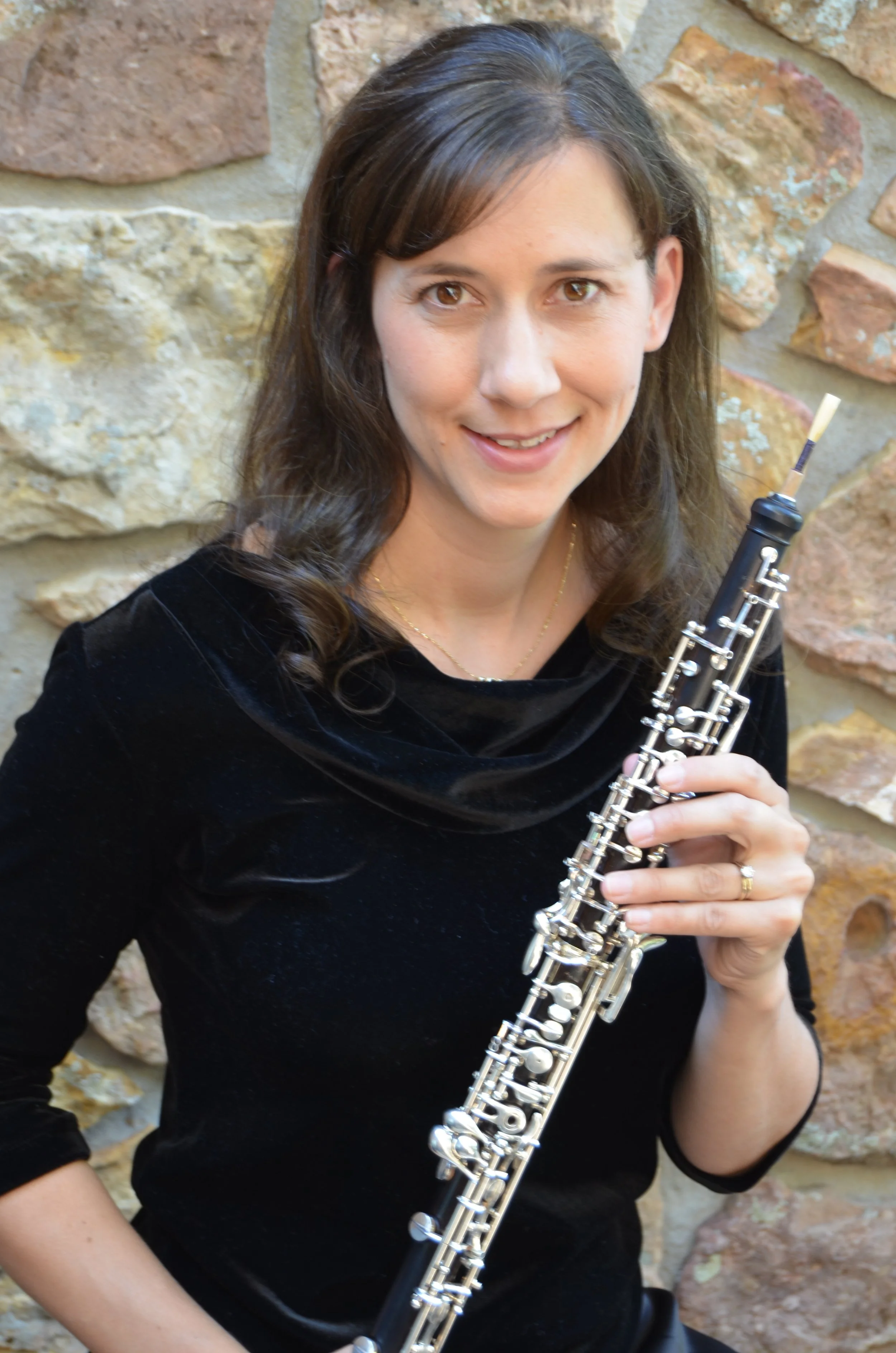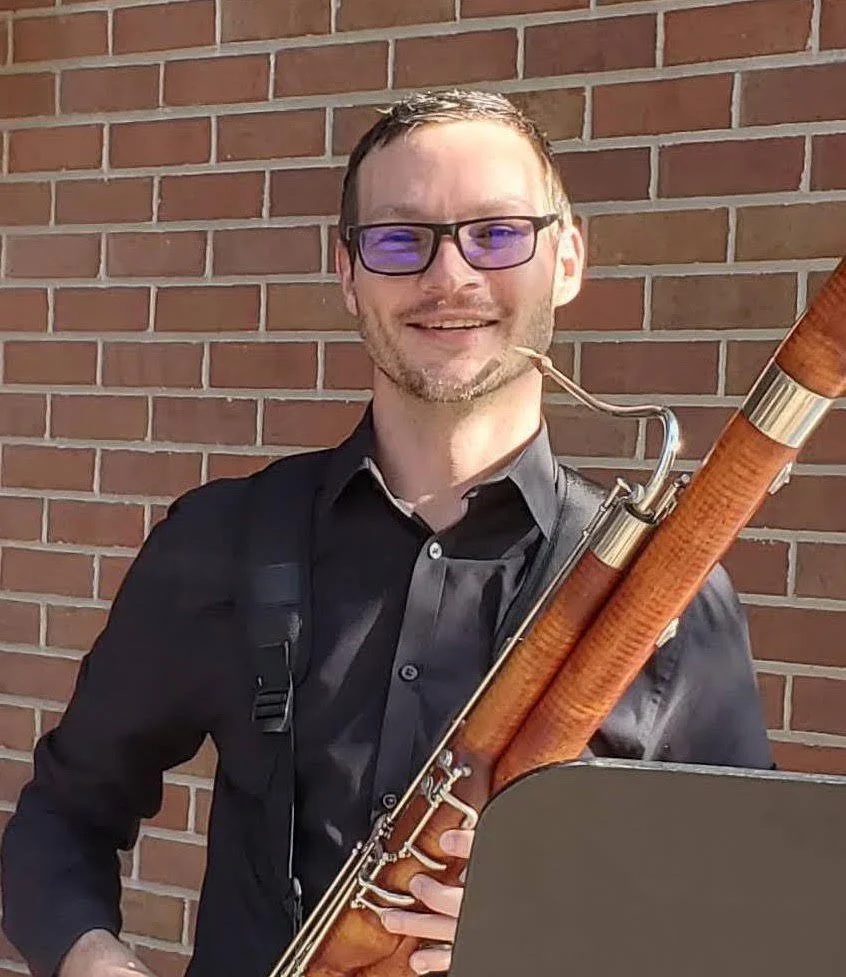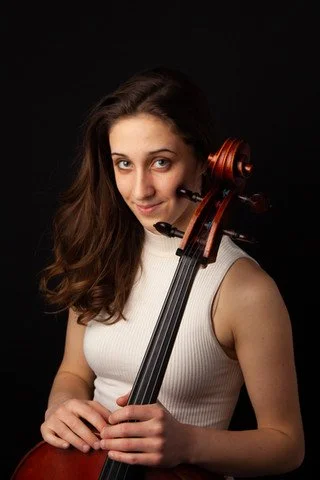
EMERGING COLORS
Saturday, March 16th, 2024 - 7PM | Broadmoor Community Church | Directions
Sunday, March 17th, 2024 - 2:30PM | First United Methodist Church | Directions
An Emerging Star & An Ancient Story
How did the world receive its color? Alyssa Morris' Tlapalli, Tlahuilli tells the story of the Aztec myth behind that question, while showcasing the Chamber Orchestra's principal woodwinds. Also taking the stage: The winner of our 2022 Emerging Soloist Competition, Annie Jacobs-Perkins, who dazzles with Haydn's Cello Concerto No. 2. This celebration of rebirth and vibrancy is perfect for the beginning of springtime.
Morris - Tlapalli, Tlahuilli: Concerto for flute, oboe, clarinet, & bassoon
Haydn - Cello Concerto No. 2 in D Major
Sibelius - Impromptu for Strings
Saint-Saëns - Orchestral Suite in D
Featuring:
-
Flutist Allison Gioscia has enjoyed a varied career throughout the Americas as an orchestral and solo artist. In addition to her role as Principal Flute with the Chamber Orchestra of the Springs, she holds the position of Second Flute with the Greeley Philharmonic Orchestra and performs regularly with the Colorado Springs Philharmonic. Previously, Allison held the position of Principal Flute with the Orquesta UniNorte in Asunción, Paraguay, performing opera, ballet, concert, and folk music throughout the country. She has also appeared as guest principal flute with the Orquesta Sinfónica de la Ciudad de Asunción, and as a guest flutist with the Orquesta Sinfónica Nacional de Paraguay and the Fort Collins Symphony Orchestra.
As a soloist, she has performed twice at the annual National Flute Association Convention (Minneapolis 2017 and Orlando 2018), and has presented concerti with the Chamber Orchestra of the Springs, the Orquesta de Cámara de Asunción (Paraguay), and the Orquesta UniNorte (Paraguay).
In the United States, Allison has held positions with such diverse ensembles as the Eclectic Laboratory Chamber Orchestra (Pittsburgh, PA), Opera in the Ozarks (Eureka Springs, AR), and the Nebraska Theatre Caravan (Omaha, NE).
As an educator, she has taught students of all ages and abilities in Colorado Springs, and was previously Professor of Flute at the Universidad Evangélica del Paraguay (CEMTA). Allison is currently proud to serve her music community on the boards of the Colorado Flute Association, the Chamber Orchestra of the Springs, and the Pikes Peak Musicians’ Association.
-
Angie Burtz joined the Chamber Orchestra of the Springs as principal oboist in 2012. She previously held principal oboe positions with the Ensemble Monterey Chamber Orchestra (CA), the Las Cruces Symphony (NM), and the Great Falls Symphony (MT), where she was also a member of the Chinook Winds woodwind quintet. She has performed frequently on both oboe and English horn with a variety of other orchestras, including the El Paso Symphony, Monterey Symphony, Santa Cruz Symphony, El Paso Opera, Glacier Orchestra, Montana Summer Symphony, and the Colorado Springs Philharmonic.
In addition to performing, she taught for a summer at Camp Encore/Coda in Maine and was the instructor of oboe for several years at New Mexico State University, while serving as a member of the faculty woodwind quintet. She received her bachelor’s degree from Abilene Christian University and concurrently pursued additional oboe studies with Charles Veazey at the University of North Texas. She earned her master’s degree in performance from Kent State University, studying with Cleveland Orchestra oboist Jeffrey Rathbun. Her Kent State University graduate woodwind quintet, Aeolus V, was a finalist in the Coleman Chamber Ensemble Competition. She participated in a number of summer festivals, including the Hot Springs Music Festival, Colorado College Music Festival, John Mack Oboe Camp, Thomas Stacy English Horn Seminar, and the Kent Blossom Music Festival. She lives in Black Forest with her husband Dan and their two teenage boys, Mason and Baxter.
-
Heike Gazetti hails from Cincinnati, Ohio, and is currently enjoying her 15th season with the Chamber Orchestra of the Springs. Heike recently began performing as Associate Principal with the Greeley Philharmonic, and has been a proud member of the United States Air Force Academy Band since 1998! While in the band, she has enjoyed a diverse touring experience across the 48 continental states in venues including Davies and Carnegie Halls with the concert band, The Macy’s and Rose Bowl Parades with the Ceremonial Band, and all places in between with chamber music groups ranging from clarinet trio to woodwind septet. In 2009, she traveled to multiple Southwest Asian countries with the chamber ensemble “Mirage”, and entertained US troops, coalition forces, diplomatic audiences, community members, and international students of all ages.
Heike received her Bachelor Degree in Music Performance from the University of Louisville and her Master of Music Performance from the Yale School of Music in New Haven, CT. During summers, she performed with the Belgian Music Festival and the Aspen Summer Music Festival, competed as a semi-finalist in the International Clarinet Association Youth Artist Competition in Paris, and received First Place chamber music accolades from the Carmel Chamber Music Competition, with woodwind quintet.
Heike began her musical studies with Cincinnati Chamber Orchestra clarinetist Miriam Culley and Louisville Orchestra clarinetist Dallas Tidwell, and went on to study with Bil Jackson, Charlie Neidich, Ayako Oshima, and David Shifrin. Additionally, much credit goes to the energetic and optimistic music educators, Mr Adams and Mr Wells, two outstanding role models from Ft Thomas Highlands High School in Kentucky, who armed Heike with the tools and courage to pursue a music career with single-minded focus.
-
Inspired by the opening notes in Stravinsky’s "Rite of Spring," Fletcher Forehand has played bassoon since the age of 13. This passion for art music has led to an ongoing role within the classical music community, serving as the principal bassoon of the Chamber Orchestra of the Springs and occasionally performing with the Colorado Springs Philharmonic on both bassoon and contrabassoon. Fletcher earned degrees in bassoon performance from Oberlin Conservatory and Carnegie Mellon University, under the guidance of George Sakakeeny and Nancy Goeres, respectively.
Fletcher is grateful to the Colorado Springs community for having such an active interest in the new, underrepresented, and unknown works presented by the Chamber Orchestra of the Springs. This relationship has contributed to the mutual musical growth of the orchestra and its audience.
In addition to performance commitments, Fletcher participates in and supports "Bassoons Without Borders," an online summer camp that welcomes bassoon enthusiasts and students of all ages from various locations. This program reflects a dedication to expanding the reach of bassoon music and education, creating a welcoming space for learning and sharing this unique instrument's capabilities..
Through achievements and contributions, Fletcher embodies the spirit of dedication to both the craft and the broader musical community, striving to share the joy and complexity of art music with a wide audience.
-
Praised for “hypnotic lyricism, causing listeners to forget where they were for a moment,” (Alex Ross, The New Yorker), cellist Annie Jacobs-Perkins is known for “eras[ing] all kinds of boundaries” (USC Thornton School of Music) with her music.
Annie is the winner of the 2023 Pierre Fournier Award. In the coming seasons she will present a recital in London’s Wigmore Hall, record her debut album on the Champs Hill Label, and perform a concerto with the London Philharmonia Orchestra. In addition, Annie is 1st prize winner of the Chamber Orchestra of the Springs Emerging Soloist Competition, Father Merlet Award from the Pro Musicis Foundation, New England Conservatory Concerto Competition, and Hennings-Fischer Young Artist Competition. She is Artist-in-Residence of the EstOvest Festival Contemporary Cello Week in Turin, Italy and the Austin Chamber Music Center in Texas for the 2023-24 seasons. Jacobs-Perkins is also principal cellist of Joshua Weilerstein’s Phoenix Chamber Orchestra and cellist of Berlin-based Trio Brontë, winners of the 2023 Ilmari Hannikainen International Piano Chamber Music Competition. She regularly performs at venues such as the Library of Congress, Concertgebouw, Jordan Hall, Wigmore Hall, Carnegie Hall, Berlin Konzerthaus, Berliner Philharmonie, Ravinia Steans Institute, Yellow Barn Festival, Marlboro Music, and La Jolla Music Society’s SummerFest.
Annie is an Artist Diploma Student at the Barenboim Said Academy in Berlin. She was a 2018 Outstanding Graduate and Trustee Scholar of USC’s Thornton School of Music (BM), the recipient of the Laurence Lesser Presidential Scholarship from NEC (MM ‘20, GD ‘21), and of the Ottilie-Selbach-Redslob Stiftung at the Hanns Eisler Hochschule für Musik Berlin (MM ‘23). Annie’s primary teachers include Frans Helmerson, Troels Svane, Laurence Lesser, Ralph Kirshbaum, Kathleen Murphy Kemp, and Guy Fishman.
WINNER of the Chamber Orchestra’s 2022 Emerging Soloist Competition
Read the Program Notes:
-
Tlapalli, Tlahuilli (Color and Light) is based on an Aztec myth. It tells the story of how the world received its color. This tone poem concerto is inspired by the beautiful illustrations in Gerald McDermott’s book that retells this Aztec myth, Musicians of the Sun. In this tone poem concerto, the listener will be introduced to the Lord of the Night, King of the Gods. This King of the Gods explains how the world is gray and colorless. He sends Wind on an epic quest to rescue the musicians of the sun (depicted by the flute, oboe, clarinet, and bassoon) from the menacing sun (depicted by the tam tam). Once rescued, these musicians bring color and light to the once gray world. In the end, everyone sings in praise and unity: Sun, the Lord of the Night, and the Musicians of the Sun.
-
One of my teachers told me this story about young Haydn when I was growing up, but it took me until I was an adult to back it up with a scholarly source. The story is as follows:
At the time the court was building the Summer Palace at Schonbrunn, Haydn had to sing there with the church musicians in the Whitsuntide holidays. When not engaged in the church he joined the other boys, climbing the scaffolding and made considerable noise on the boards.
One day the boys suddenly perceived a lady; it was Maria Theresa herself, who at once ordered some one to drive away the noisy youngsters, and threaten them with a whipping if they were caught there again. On the very next day, urged on by his temerity, Haydn climbed the scaffolding alone, was caught and received the promised punishment which he deserved. Many years afterward, when Haydn was engaged in Prince Esterhazy’s service, the Empress came to Esterhaz. Haydn presented himself and offered his humble thanks for the punishment received on that occasion. He had to relate the whole story, which occasioned much merriment.
This anecdote comes from one of Haydn’s friends, the painter Albert Christoph Dies. I still can’t say for sure whether the story is true–Dies’s biography of Haydn has a decidedly artistic flair and is not necessarily the most accurate–but it fits with the picture I have of Haydn in my head. Just like the boy Haydn who climbed palace scaffolding to feel wind on his face and the adrenaline rush of almost being caught by his elders, his music is similarly on the hunt for joy and mischief.
The D Major Cello Concerto was written for the cellist Anton Kraft in 1783, a virtuosic solo cellist alive during a time when the cello was considered primarily an accompanimental instrument. Up until 1951, many actually attributed this work to Kraft himself because Haydn’s manuscript had gone missing and the writing is so cellistic. Though the work is certainly by Haydn, it is clearly a collaboration between cellist and composer. Many of the jokes that show up are specific to the cello; Haydn was clearly using the instrument as a means to experiment with color and timbre.
The first movement is full of markings quite rare for the time period. In one place, Haydn instructs the cellist to play high up on the G string, creating a sound that is dark and muted, thuddy. In another passage, he instructs the cellist to play in the stratosphere of the A string, marked flautino or “floating.” In another, the solo cello finishes a phrase as softly as possible before the orchestra comes in with a subito forte for two notes; then the orchestra and soloist return to piano for the beginning of the next phrase. I almost always think of Haydn as speaking music rather than singing music, but the second movement of this concerto seems to find a perfect balance between the two. It really is one of my favorite movements of all time–I hope you enjoy it! The concerto closes with a rondo built on the theme of a hunting song.
-
Finnish composer Jean Sibelius dedicated his life’s musical work to his native country. His music is saturated by the influence of Finland’s language, traditions, and extensive folklore. Perhaps more significantly, however, his works reveal a much more organic connection to his homeland. Sibelius drew creative energy from the very soil of Finland; its mountains, rivers, valleys, and forests all contributed to his inimitable musical language. Although Sibelius’ music ranges from hyperconservative to, at times, startlingly modern, his works always seem to germinate from the sights, sounds, and smells of the natural world.
Sibelius entered university in Helsinki as a law student, but it quickly became apparent that music was his calling. He initially endeavored to be a violinist, but his natural abilities on the instrument were far surpassed by his talents in composition and he began serious study as a composer first in Helsinki and later in Berlin and Vienna. When Sibelius embarked on his career as a composer in earnest, he found immediate success in 1892 with his tone poem Kullervo, the first of many such works inspired by the legendary Finnish epic, the Kalevala. The following year, he composed a set of piano Impromptus, Opus 5, and these were the first to be published among many short piano works Sibelius composed throughout his career. Sibelius biographer Guy Rickards called these “one of [Sibelius’] most charming sets of piano pieces,” and the collection has remained exceedingly popular with both professional and amateur pianists alike. The Fifth Impromptu is especially regarded as a miniature masterpiece and is firmly established in the repertoire of most Finnish pianists.
Sibelius did not compose any new music during the last twenty-five years of his life, yet he arranged several of his piano works for orchestra and often revisited other music he had composed many years prior. His Impromptu for String Orchestra is one such piece and cleverly combines the fifth and sixth piano pieces from the Opus 5 set, in E minor and E major respectively. The outer sections feature the noble and lyrical lines of the Fifth Impromptu, while the gentle waltz feel of the Sixth Impromptu serves beautifully as the central “trio” section of this creative synthesis. The music of the Sixth Impromptu was also used in Sibelius’ Melodrama from ‘Svartsjukans nätter’ (‘Nights of Jealousy’), where it accompanies the text “if you once stood, shrouded in the misty haze, on the hilltop, in the spring morning’s embrace….”
-
Parisian-born Frenchman Camille Saint-Saëns, despite an early childhood marred by the death of his father and frequent bouts of tuberculosis, began his musical studies at the age of 3 and quickly became renowned as one of history’s greatest piano prodigies. His mother, not wanting him to become too famous at too young an age, delayed his concerto debut until he was 10 years old. Always performing from memory, an unusual feat at the time, he precociously announced to his audience that for the encore they could elect to hear any one of Beethoven’s 32 piano sonatas. He entered the Paris Conservatory at the age of 13, studying organ and composition, and earned his premier prix in 1851. By 1857, aged only 22, he was appointed organist at La Madeleine. After hearing him improvise there, Franz Liszt declared that Saint-Saëns was the greatest organist in the world..
The Suite for Orchestra in D, Op. 49 was composed in 1863 as a work for harmonium - a small, organ-like instrument with foot-operated bellows that push air through metal reeds. Having been invented in 1840, the harmonium was still relatively new and was very popular in France. Like the piano, the harmonium was perceived as something of a “home orchestra,” making Saint-Saëns’ suite a natural candidate for orchestration, which the composer completed in 1869. The movements of the Suite are loosely modeled on the dances of French Baroque suites à la Rameau and Bach, and long drones, a vestige of the work’s harmonium roots, give it a rustic, pastoral feel.
The early 1860s were a contented, uncomplicated time in Saint-Saëns’ often tragic life. Despite his young age, he was enjoying a well-established reputation and prestigious positions, and in his personal life he was happily beginning what would be his lifelong mentorship of Gabriel Fauré. Saint-Saëns tranquility and joy are on full display in this music - it is uncomplicated, a celebration of beautiful lines and colors with nothing to prove. May we all carry this feeling with us as we emerge from our time together back into the world.
Preview the Program Guide:
WHAT TO KNOW
VENUES
Saturday evening’s concert is held at Broadmoor Community Church.
The venue for Sunday’s concert is First United Methodist Church.
Doors open 1 hour prior to the performance.
Subscribers’ tickets are valid for Saturday OR Sunday - and all seating is general admission.
PARKING
For Saturday’s concert at Broadmoor Community Church: Parking is free on-site.
For Sunday’s concert at First United Methodist Church, free parking is available next to the building and across St Vrain Street.
PRE-CONCERT LECTURE
Pre-concert lecture by Robert Bruce - on-air host at KCME - to begin 45 minutes before the performances.






